Chapter 1. Protocols, Doctrine, and Philosophy
Chapter 1. Protocols, Doctrine, and Philosophy
Philosophy
“It is men who wait to be selected,
not those who seek,
from whom we may always expect the most efficient service.”
General Ulysses S. Grant
There are those who believe that self styled generals should not tell them what to do. If you are one of these, you have picked up the wrong manual. All human beings are drawn to leadership. This is not to say that all leaders are good. Indeed, many of the best leaders have achieved their status by accident. In paintball, everyone has the opportunity to serve and lead at one time or another, by attrition if nothing else.
The 1st Paintball Light Infantry Battalion was formed by paintballers, for paintballers to increase our enjoyment of the newest and (to many of us) the best part of paintball, the scenario game. The PLI recognizes that paintball is essentially simulated combat and that the majority of players want to play army. To make that goal more achievable and increase the enjoyment of all, the 1st PLI was formed. The unit attempts to complete the fantasy offered by big game scenarios by providing the opportunity to be a member not only of a larger organization, but one that stays true to the military heritage of the sport.
Since the PLI only comes together as a unit three to four times a year, it is necessary that each member study his manual, memorize those areas appropriate, and understand the basic tactics and doctrine contained herein. All members are expected to maintain their local team memberships in order to gain experience and participate in all that paintball has to offer. When participating in official PLI events, members are expected to submit to the orders, rules, protocols, and mission of the PLI.
The PLI does not exist so the few can lead the many, as such the command of forces in the field is rotated from event to event from among the representatives elected from each local team to represent them. (This is covered in detail in the organizational by-laws in Appendix E).
There are no dues for joining the PLI. The money collected from you and your men to join paid for this manual. In the event the board of directors votes to spend money, it will become the property of the PLI and the cost will be spread equally to all.
The PLI is for team players that want the full experience of playing army, paintball, big game scenarios, and being victorious with honor. It is not an organization for hotdoggers or those who do not practice stringent safety rules or insist that they have the best way to do something and will do it no matter what. When a member of the PLI receives an order, it must be followed. Unit coordination through the PLI insures that even orders which sound nonsensical have a purpose that could be to support another objective or attack about which the individual player knows little.
In order for the PLI to continue to be successful, it is necessary that each and every member be responsible for learning the tactics, radio procedures, basic requirements, and operating procedures contained in this manual. Welcome to the Infantry!
Mission of the 1st Paintball Light Infantry Battalion
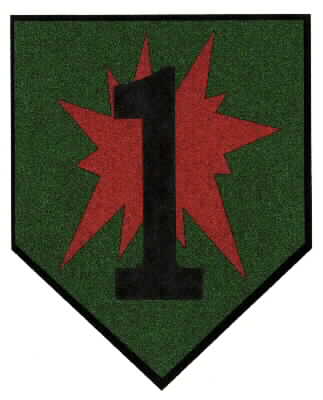
It is the mission of the 1st Paintball Light Infantry Battalion To enhance the paintball experience for like minded players by providing a framework of tactics and standardization of communications and command and operating procedures to fulfill the military fantasy of the members and to provide each member with the opportunity to lead and follow in a realistic military combat situation. This will be accomPLIshed with integrity and honor by all members who shall place these values above victory!
Goals
1. Provide the most realistic simulation of military operations possible for the enjoyment of our members.
2. Provide the opportunity for each member to experience leadership.
3. Participate as a unit in three big scenario games a year and host one.
4. Host an annual PLI training camp for members only.
5. Establish a foundation of safety, training, leadership, tactics, and communications.
6. Actively recruit like minded players.
7. Encourage growth of the sport by teaching new players, not berating or belittling them.
8. Spread the concept of honorable fair play at all events where members participate.
9. Educate the public about the sport of paintball.
10. Enjoy ourselves immensely win, lose, or draw.
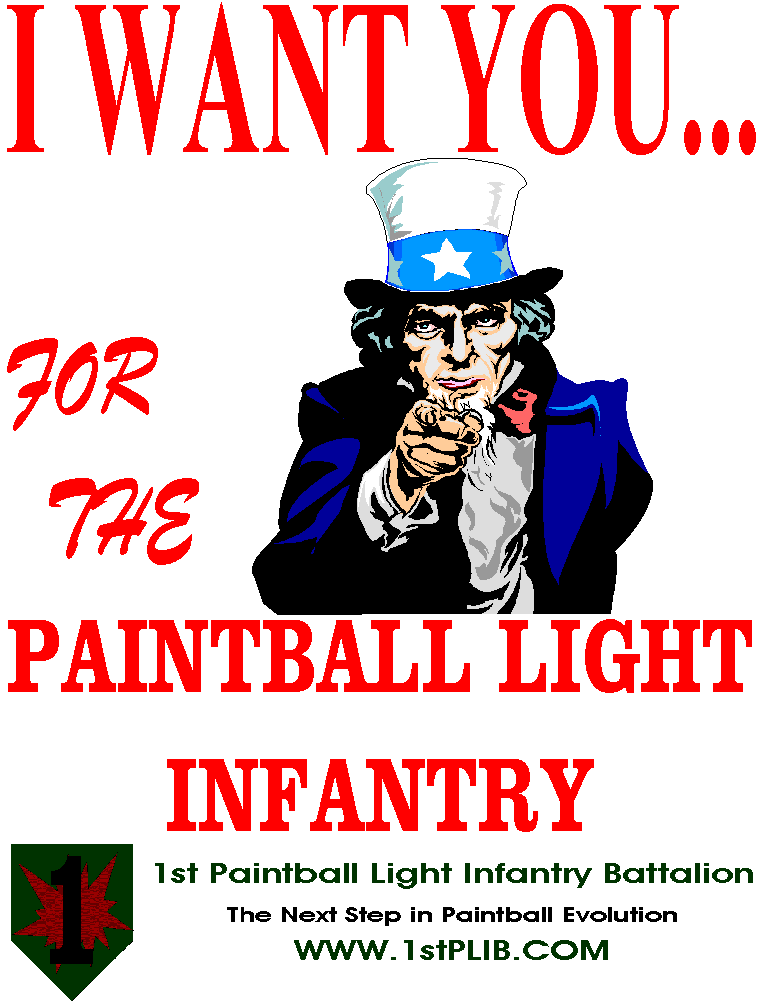
“Duty is the sublimest word in the English language”
General Robert E. Lee CSA
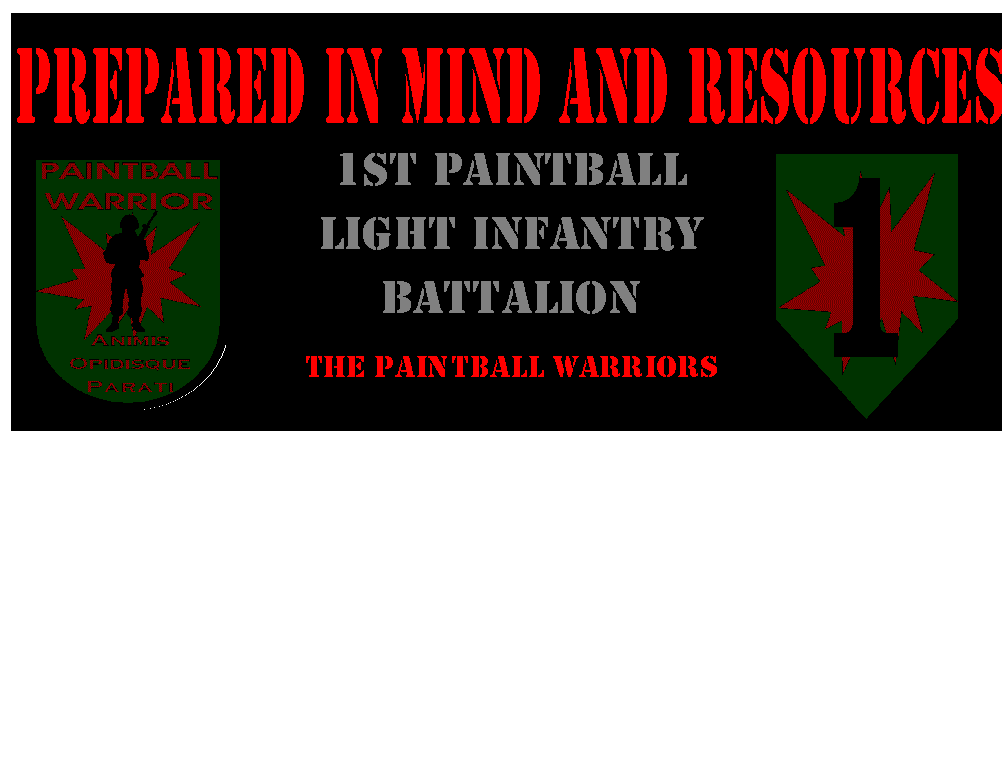
The Paintball Warrior Battle Doctrine
The PLI Paintball Warrior is a concept whose time has come. It isn't a crazed paintball maniac wielding the newest and best weapon on the market. The Paintball warrior (PW) is a player whose mind is his (or her) most essential piece of equipment. They are players who live for the scenario recreation game. They study tactics not just before an event, but any time they can. They pour through paintball magazines (skipping the articles on who won what tournament and who came to it) and pull out the essential new elements of the sport. As they walk through the isles of Wal-Mart, they see ordinary household items that can be used as the perfect "something". Their spouses (if any) have given up on them.
The Paintball Warrior concept is based on a combination of the USMC's Urban Warrior and US Army's Airland 2000 Battle Doctrines. For the Marines, Urban Warrior is a way of fighting in urban terrain that emphasizes effective use of self supporting squad and platoon tactics. Airland 2000 stresses the strategic principles which led to victory in the Persian Gulf. For Paintballers, they are combined into a way of playing recreational scenario games. Under Urban Warrior, an individual soldier must be able to carry the weapons and supPLIes that will allow him to combat every potential threat and survive. Under Paintball Warrior, the "soldier" carries those paintball devices which will allow them to respond to any paintball threat. This means more than the current "hot" paintball gun. It means an effective primary and secondary weapon, paint grenades, a CO2 powered paintball assault weapon, mines, and other equipment necessary for winning the engagement. Paintball Warriors also live for the military fantasy of the game. They don't care if they are portraying the Colonial Marines, Starship Troopers, Imperial Stormtroopers, or brave rebel commandos, they just want to join the army for the weekend.
The First Paintball Light Infantry Battalion is the natural home for this new breed of paintballers. By standardizing basic tactics, communications, immediate actions, and command structure, the 1st PLI allows small five man teams to come together as a Battalion of organized and like minded paintballers. By adopting the US Army's Airland 2000 Battle Doctrine to the paintball world we further define an effective system of "imitation" combat.
The Paintball Warrior Battle is the doctrinal basis for meeting the challenge presented by big scenario games. It involves maneuver at all levels from the squad to the battalion and tries to use the full potential of modern paintball weaponry. It is offensively oriented so PLI commanders may go to the offense as soon as possible. No matter what level the conflict, the side that keeps the initiative through offensive action forces the other side to react rather than to act. The thrust of Paintball Warrior Battle doctrine is to disrupt the enemy's synchronization, preventing him from applying combat power at a decisive point; and to create opportunities for PLI to be victorious.
Success on the paintball battlefield depends on commanders at all levels understanding and implementing the basic tenets of the Paintball Warrior Battle doctrine: initiative, depth, agility, synchronization, technology, and weaponry.
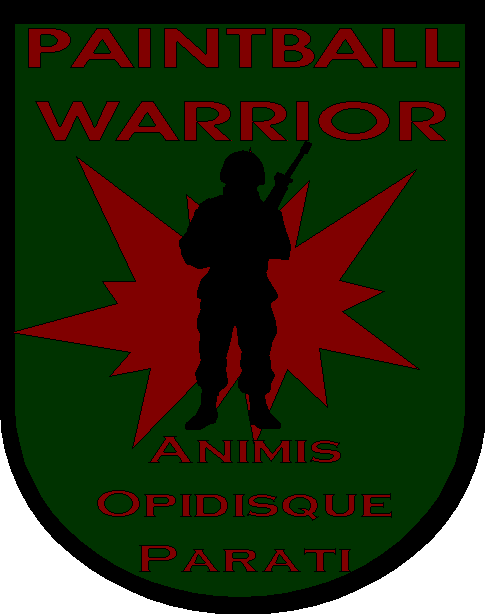
Basic Tenets of Paintball Warrior Battle Doctrine:
a. Initiative. This is the ability to set or change the terms of battle through action. It requires commanders to maintain an offensive spirit. It means that, when an opportunity presents itself, the commanders may depart from planned actions to hasten mission accomPLIshment. To do this without jeopardizing the higher plan requires that the commander understand and work within the intent of the commander two levels up. This imPLIes a degree of independence and risk. Commanders translate their initiative into action by issuing mission-type orders. These orders in turn give subordinate commanders the flexibility, within the scope of their commander's intent, to improvise and act aggressively to accomPLIsh assigned missions and defeat the enemy. In addition to understanding the scope of their commander's intent, each leader must understand his unit's part in the commander's concept (as the main or a supporting effort), so that he may confidently and boldly exploit success.
b. Depth. This is measured in time, distance, and resources. At battalion level, depth is achieved by positioning forces to deny the enemy the ability to maintain mass, momentum, and mutual support. The battlefield is no longer a one-dimensional or two-dimensional entity. The commander must understand how he and the enemy fit into the higher commander's deep, close, and rear battles. When possible, reserves are employed. This gives depth to the battalion and provides the commander with a form to counterattack and completely destroy the enemy.
c. Agility. This is the ability to think and act faster than the enemy. It involves mental, command and control, and organizational abilities to adjust rapidly and to use the situation, terrain, and weather to defeat the enemy. The plan must be simple, yet flexible enough that the commander can react when an opportunity presents itself.
(1) Mobility, flexibility of task organization, timely intelligence, and rapid decision-making enable the commander to cause the enemy to react, which sets the terms of the battle. At the battalion level, these terms are often simPLIfied by positioning the command group well forward so they can see the battlefield, recognize opportunities, and rapidly seize the initiative. The commander and his subordinates rely on IPB, a sound R& S plan, and accurate reports to quickly understand enemy intentions.
(2) Reaction time is reduced by rehearsing SOPs and drills, by choosing sound initial positions for dismounted units that simPLIfy their ability to maneuver. Assets from CS and CSS are positioned to sustain the main effort and to provide flexibility to the plan. Complexity reduces agility.
d. Synchronization. This is the arrangement of battlefield activities in time, space, and purpose to produce the greatest possible relative combat power at the decisive point. Synchronization is both a process and a result.
(1) Synchronization extends from planning the maneuver to integrating small five and ten man teams into effective platoon and company organizations to achieve mission accomPLIshment.
(2) Leaders at all levels must understand friendly and enemy capabilities. They must know how to relate these capabilities to time and space to produce synchronized plans that satisfy the commander's intent.
(3) Synchronization begins in the mind of the commander with his concept of operations. The concept must clearly focus the main effort at a decisive point and must clearly designate the effects (tasks and purposes) of the subordinates. Understanding and using a common doctrine and military language enhances synchronization.
(4) The commander creates synchronization by developing, issuing, and rehearsing clear, succinct orders supplemented by well-established SOPs. Using SOPs enables the commander to rapidly employ assets and to seize tactical opportunities without lengthy explanations and orders.
e. Technology. PLI forces strive to use technology to its advantage by standardizing the equipment purchased by its members. This includes global positioning systems (GPS), family radio service (FRS) Radios, night vision devices (NVD's), and other technological advances in the sport.
f. Weaponry. The PLI uses all matter of paintball weapons. This includes those commonly called alternative or milsim paintball weapon. It includes compressed air cannons, mortars, grenades, mines, armor, and air support.
The PW's equipment reflects the scenario game philosophy. They carry a backup weapon because you shouldn't be a casualty just because your main gun is down. They carry Paintball Assault weapons for taking out bunkers and large crowds of enemy players. They have smoke and paint grenades ready to go. They come equipped with Talkabout Plus radios, and extra batteries. Their uniforms aren't red, blue, or yellow but camouflaged, usually with Advantage or Realtree Camouflage. Their weapons are black or camouflaged, and they cringed when they saw a red anodized paintball gun for the first time.
Paintball Warriors live for the military fantasy of a good scenario game and do not generally agree with the way "mainstream" paintball has tried to distance itself from the military. Of course they also think that recreation ball paintball is the mainstream! The First Paintball Infantry Battalion exists to promote the military fantasy of paintball by combining the Organization of Civil War Reenacting and the game of paintball with tried and true military principles. This allows like minded Paintball Warriors to come together with a system of operating and communicating effectively on any field at any time.

Paintball Warrior Patch and Motto
"Animis Opidisque Parati"
Prepared in Mind and Resources
Rules of Engagement
1. Play with honor and integrity at all times, placing these values above victory.
2. Play within the prescribed game format, faithfully executing all missions, rules, and protocols required to complete the mission.
3. Obey all local safety rules and those of the unit.
4. Do not tolerate cheaters in any way, at any time, for any reason. Each member must understand that any confirmed instance of cheating or unsportsmanlike conduct is grounds for dismissal from the event and will be reviewed by the board of directors for court-martial and dismissal.
5. Promote the sport by encouraging and helping new players.
6. Refrain from the use of profanity both on and off the field.
7. Obey the golden rule “do unto the other team as we would have them do unto us.”
8. Avoid close shots by offering the opportunity to surrender.
9. Observe strict safety guidelines and recognize that safety must be inherent in the sport for it to grow and continue.
10. Winning will always be treated as secondary to the enjoyment of the sport, unit comraderie, exercise, teamwork, and improvement of personal skills.
11. Obey all camp rules of safety when in camp.
12. Alcohol and illegal drugs are forbidden and grounds for dismissal from the event and court martial from the unit.
13. Always treat your paintball gun as if it is loaded.
14. Follow orders and assignments to the best of your ability within the confinements of the rules of the scenario.
15. Endeavour to represent the 1st PLI, the sport, and the event in the best possible manner.
“A cadet does not lie, cheat, or steal or tolerate those who do.”
The Citadel Code of Honor
Zero Tolerance Policy
The PLI adheres to a strict zero tolerance for the use, intended use, possession, transportation, or distribution of any illegal substances. Violations of this policy will result in immediate removal from the event, immediate (within 24 hours) DisciPLInary Court-Martial, and notification to the appropriate law enforcement agency for conferring of charges.
Intoxication by Members. Members of the PLI are strongly encouraged not to drink any alcoholic beverages during unit events, this particularly apPLIes to members serving as officers or non-commissioned officers. No alcoholic beverages will be carried onto the field of battle or staging areas of the event. Alcohol should be confined to the PLI permanent camp, parking areas, or designated locations. In the event a member chooses to drink they will not be allowed to drive their vehicle offsite or participate in the event until cleared by the event commander. Any member who becomes intoxicated will be subject to immediate removal from the event and DisciPLInary Court-Martial. Violations of the law will be reported to appropriate law enforcement agencies.
Drinking by Underage Members. PLI members who are under the legal drinking age are not allowed to drink alcohol at unit events. Violation shall result in immediate dismissal from the event, notification to parent or guardian, and DisciPLInary Court-Martial and notification to appropriate law enforcement agency for conferring of charges if necessary.
Interaction with Other Units. In the event the PLI interacts with any other unit at non-PLI hosted event, members are expected to display appropriate decorum and abide by the PLI policy. Violations of the event rules, or any violation that the member feels constitutes a safety issue, shall be reported immediately to the Event Commander. The event commander shall do all that is necessary to insure the safety of members up to and including withdrawal of the PLI from an event.
Enforcement. All members of the PLI are responsible for enforcing the drug and alcohol policy. Violations should be immediately reported to the EC and Event Commander who will take immediate action on the violation in accordance with the By-Laws and General Orders.
This policy is intended to be strictly adhered to at all PLI sponsored, attended, or protocol type events.
Responsible use of Full Auto Paintball Guns
The present debate over the use of full auto paintball guns is similar to the debate we once had over semi-automatic guns. Paintball, especially recreational paintball, has evolved to a new stage. Full auto weapons are not going away. Instead of expecting local fields to purchase expensive shot counters and other high tech devices, the PLI stands for the responsible use of full auto guns.
As advocates of MILSIM paintball, the PLI believes every five man squad should be allowed to have at least one Squad Automatic Weapon (SAW) in big/scenario games. Why? Because it brings a new element into the game. This new element allows paintball to move from a game of equal checkers to a game more akin to chess with more than just pawns. The paintball chess set includes snipers, semi gunners, full auto, paintball assault weapons, grenadiers, mortar men, squad leaders, and commanders. As technology improves, the paintball chess set will expand to include even more "pieces" to make the game more interesting. Modern infantry squads are built around a machine gunners and grenadiers who have firepower equivalent to the entire rest of the squad! Take out the machine gunner, and you have a decided advantage. The difference in firepower is slightly less because even the best full auto gun still has limited range, but it still adds a new element to the game.
The SAW gunner must be protected by the rest of his squad. The whole idea of sniping at one player begins to make sense if your squad's sniper can take out another squad's machine gunner. This would result in a decided advantage to the squad who took out the full auto "machine gunner" even if they lost their sniper in the process.
The PLI believes all teams should have the ability to field the gamut of paintball chess pieces in the field, especially in the big game or scenario game operation; However, there is a problem if thirty regulars go full auto against 30 new recruits with rental guns during a pick up or recreational game. Full Auto paintballers must exercise good judgement and "UNcommon sense" to know that full auto is a tool that MUST be used appropriately. Balance is vital in pick up games and the PLI recognizes the difference that exists and the concerns local field owners have when this sort of situation occurs. If there is only one full auto gunner, he should stay in semi mode. If there are four, they should be sPLIt equally on different teams to allow equal firepower. The truth many are ignoring is that we have been "overshot" for years. One reason we get hit repeatedly is that we always yell "paintcheck" instead of "hit" because the ball may have bounced and we all know if we say "hit" the judge will call us out no matter what. We know this and accept getting hit three times while checking the spot to make sure we were marked. The best option to stop overshooting would be to get rid of bounce rules and make a general rule that if you are hit, you are out, regardless of wether the ball splatted or not. Sure some would cheat, but they're the ones who do now anyway!
Another argument against the use of full auto markers is that full auto makes paintball look "too military". Since when did we become ashamed of the military? Most of us have played "ARMY" since the age of two. What is wrong with that? Paintball is the ultimate attempt to play army by grown men. This is not to detract or take credit from ANY of our veterans, their sacrifice will not be forgotton as long as the PLI is around. Thif manual is in fact dedicated to the first company to hit Omaha beach on D-Day. Paintball is an opportunity for everyone to experience the intensity of combat without getting wounded or dying. It is best described to the non-player as an attempt to understand the intense comraderie developed by our combat vets. A paintball player will be the first to tell you just how dangerous a combat situation must be. Fortunately, thanks to our veterans, Paintball is as close to combat as most of us will ever get.
Full auto paintball brings an incredible new element to the sport AS LONG AS it is used responsibly. The ideal PLI squad consists of two full auto gunners, two semis, and a pump or sniper gunner. We train around the full auto gunners for assault tactics, and teach our snipers to go after the enemy full auto gunners. For big games, FA is awesome. For a weekend at the local field, we must not abuse new players. Use it responsibly or lose it!
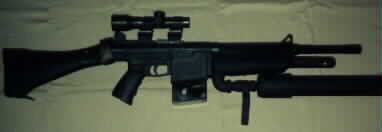
The Paintball Light Infantry Battalion Protocols
The Paintball Light Infantry Battalion Protocols is a system whereby small groups of PLI units may function under the umbrella organization and name of the PLI at events not "officially" attended by the entire membership. Numerous local fields host scenario games throughout the year. The PLI will generally not be able to attend any but the largest games and events that the unit hosts, but recognizes that small groups of PLI units may wish to participate in these smaller scale scenario games. Since the PLI stands for initiative and leadership, we certainly want to encourage this participation. Additionally, the PLI will benefit in the long run from those PLI units practicing the tactics and communications together.
The PLI Protocols are the Mission, Goals, Rules of Engagement, and Philosophy of the PLI. Local units who wish to attend events representing the PLI need only notify PLI HQ of that intent. This allows PLI HQ to be aware of the event, publish the unit(s) intent for other PLI units to know and join them, and support the local unit as much as possible. The units will be expected to exhibit the strict standards of behavior demanded of PLI members at official PLI events. Further they must strive to use the tactics and standardization of the PLI and are encouraged to use the Company Event Matrix for those local PLI units that wish to participate. The following list of mandatory protocols must be in effect for the local units to represent the PLI. Suggested protocols should also be used. In the event a local team assumes a leadership role, they would naturally be allowed to assume the command position. The Command Rotation of the By Laws is only for those events that the PLI attends as a unit (generally national level events), not local events planned by your team.
Mandatory Protocols:
1. Mission
2. Goals
3. Rules of Engagement
4. Zero Tolerance Policy
5. PLI By Laws and General Orders
Suggested Protocols:
1. Company Event Matrix
2. PLI Uniform
3. PLI Squad, Platoon, and Company Tactics
4. PLI Communications
Local PLI team should endeavor to follow all PLI procedures as possible. They must remember that the ENTIRE PLI will be judges on their actions and should act accordingly. Violations of the By-Laws should be reported to PLI HQ immediately.
The PLI assumes no responsibility for damages of units operating under the PLI Protocols as outlines in the PLI Waiver of Liability.








